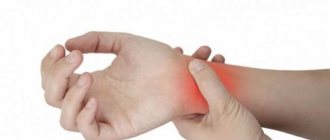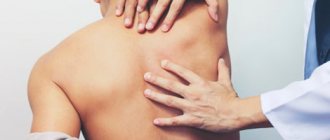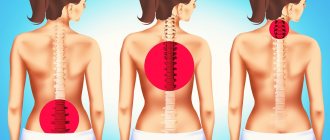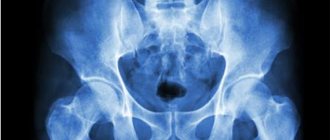Pain in the hand can be caused by various reasons. The whole arm or some part of it may hurt. The pain can be of a different nature: dull, burning or numbing, shooting or piercing, etc., it can occur suddenly or develop gradually.
Typically, people experiencing pain in their hand complain of:
- Pain in the wrist, palms and hands;
- Elbow pain;
- Shoulder pain;
- Pain in the shoulder blade.
Pain in the hand is often a consequence of various injuries, overexertion, and can occur as a result of excessive physical activity or prolonged work in an uncomfortable position. For example, a common occupational disease in our time among those who work at a computer for a long time has acquired the name “tunnel syndrome.” Pain in the arm can be one of the symptoms of diseases of the cardiovascular system, musculoskeletal system, nerve trunks and endings.
If there are no visible external injuries, it is necessary to check the condition of the cervical spine, since the cause of pain may be a protrusion or herniation of the intervertebral disc. Pain in the hand is not always felt directly at the site of injury; if the wrist is affected, it often spreads to the forearm area. Sometimes pain in the upper arm occurs as a result of heavy lifting. It can also be caused by an inflammatory process in the tendons of the shoulder muscles.
If pain has already appeared, discomfort does not go away for more than 3 days or periodically recurs for no apparent reason, you should go to an orthopedist.
Important information: Dear patients! If you have been diagnosed with rheumatoid arthritis, you need to see a rheumatologist. With a rheumatological profile, in addition to the joints, internal organs (heart, kidneys, etc.) may also suffer, so rheumatoid arthritis should be treated by a rheumatologist. The treatment of allergic, gouty and infectious arthritis is carried out by specialists of the relevant profile (allergists, rheumatologists and cardio-rheumatologists).
Orthopedic doctors successfully treat all other types of arthritis in children and adults (caused by sports and household injuries, excess body weight, age-related changes in joints).
Causes of pain in the joints of the hands
Given the current state of development of science and medicine, when it would seem that so much has been created for a complete cure, it seems incredible that the problem of pain in the hands remains relevant for many.
There may be several causes of pain in the joints of the arms and hands:
- this may be a previous and not fully cured hand injury, heavy professional stress on the joints of the hands, a previous illness, psychological stress;
- development of arthritis and arthrosis;
- Constant work at low temperatures (hypothermia) or large temperature changes significantly increases the possibility of developing various inflammations in the body, and, accordingly, affects the weakest human joints, such as the joints of the hands or feet;
- diseases of the spine (osteochondrosis, vertebral displacement, hernia and protrusion of the intervertebral disc, etc.) - pain in the arms can be one of the symptoms of these and other diseases;
- diseases with poor posture - pain in the arms can be a secondary symptom of these diseases or reflected pain due to overstrains in the muscles and joints.
If you feel discomfort in your hands, pain in your joints, or you have already been diagnosed, but are putting off treatment, then you need a visit to a specialist and competent treatment right now!
Why is working at a computer bad for your hands?
Your hands, elbows, and shoulders weren't designed for hitting keys all day. The most natural movements are multi-joint ones. To pick something up from the ground you need to work with your legs, back and arms. Long-term use of fingers with the forearm and shoulder “off” develops an incorrect stereotype of actions.
As a rule, we type while sitting (the most unfavorable position), the hands are slightly elevated (the extensors of the fingers and hands are overstrained), the fingers make thousands of movements (the cartilage and tendons become thinner). For example, in one day a manager’s fingers press keys up to 25 thousand times, and a designer’s mouse “travels” a distance of 1 km! Such accentuated overload always entails a certain pathology.
Why do my hands hurt?
To answer this question, you need to undergo a competent and comprehensive diagnosis at the Alan Clinic Center for Neurology and Orthopedics, which, with its comprehensive approach to identifying joint problems, will help establish your diagnosis. Diagnostics includes the following research methods:
- consultation with an orthopedic doctor;
- special orthopedic tests;
- dynamic active and passive tests;
- local palpation examination of damaged joints;
- assessment of the condition of the musculoskeletal system, posture, gait, uniform distribution of load on joints, range of motion, stability and strength of the joint;
- making and explaining the diagnosis;
- selection of individual complex motivated treatment.
If necessary, the doctor may also prescribe:
- MRI;
- Ultrasound;
- X-ray;
- lab tests;
- diagnostic puncture of the joint.
How to treat hand joints?
All existing treatment methods, both the most modern and traditional, which the Alan Clinic Center for Neurology and Orthopedics uses in its work, are safe and exclude surgical intervention.
The treatment process is always a comprehensive program with an individual approach to each of our patients.
Most of our methods, which are essentially drug-free, are acceptable even for the treatment of infants, pregnant and nursing mothers. We have at our disposal the following methods:
- Manual therapy
- Osteopathy is treatment done by a doctor, with a gentle effect on the musculoskeletal system, nervous and vascular systems, and internal organs.
- Medical massage
- Acupuncture - exposure to biologically active points with microneedles.
- Laser reflexology is a painless effect on reflexogenic zones and points.
- Tsubotherapy is a gentle effect on the reflex points of the body.
- Pharmacopuncture is the introduction of medicinal drugs of natural origin to the source of the problem.
- Plasma therapy is the introduction of the patient’s own purified blood into the site of the disease.
- Isometric kinesiotherapy - individual gymnastic techniques/exercises, according to indications, with elements of joint massage.
- Kinesiotherapy using the Exart installation
- Kinesio taping
- Ozone therapy is treatment with active oxygen.
- Physiotherapy
- Physiotherapy with enzyme preparations
- Medical droppers
- Hirudotherapy - treatment with leeches.
- Botulinum therapy is treatment with botulinum toxin.
- Intra-articular injection of synovial fluid endoprostheses
- Intra-articular blockades
All methods are recognized by official medicine, and doctors using them have appropriate certificates. The decision on the need to use certain medications during the course of treatment is made by the doctor, based on the complexity and severity of the disease, concomitant diseases, as well as the diagnosis.
Heart hurts, left hand goes numb, reasons
Pain in the left arm and heart appears when the functioning of one of the systems in the body is disrupted. Numbness of the limbs on the left is a clear sign of the development of the disease. Experts identify a lot of reasons that influence the deterioration of well-being. They are divided into cardiac and non-cardiac causes. Among them:
Cardiac causes of heart pain and numbness in limbs
- Cardiac ischemia. With coronary heart disease, the patient feels a sharp dagger pain in the heart area, which radiates to the left arm. In such situations, you cannot do without painkillers and without the help of doctors. We are talking about damage to the heart muscle. Stress, emotional stress, and chronic lack of sleep lead to the development of cardiovascular disease. Also, coronary heart disease occurs in people who work physically. The patient's heart and arm hurt. In advanced cases, deterioration in health is accompanied by dizziness and a pulling sensation in the left shoulder area. The person is in a state of panic and breaks into a cold sweat. The nervous system is overloaded and therefore cannot function normally. If ignored, these symptoms lead to myocardial infarction and angina. An attack of angina lasts about ten minutes. It is recommended to use nitroglycerin and vasodilators. Do not self-medicate. The KDS Clinic will prescribe the necessary treatment and stop the progression of the disease.
- Myocardial infarction. The heart hurts and radiates to the arm when myocardial infarction develops. The disease is extremely dangerous to human life and will lead to death. There is a strong sharp pain in the heart, the hand goes numb. In some cases, the face also becomes numb. The patient feels a panicky fear of death and is shaking. If symptoms worsen within an hour and do not stop after taking medication, then the patient is guaranteed to have a heart attack. It's worth calling an ambulance. Sometimes a myocardial infarction goes away without any symptoms.
- Myocarditis. Heart and arm pain due to myocarditis. This pathology indicates serious disorders of the cardiovascular system. The disease is not easy to diagnose. Symptoms include shortness of breath, tinnitus, constant fatigue, insomnia, a feeling of anxiety and fear for your life, dizziness, and cold sweats. The patient is concerned about tachycardia and blood pressure disorders. Severe pain appears in the chest and heart. Hands and feet become numb. The development of myocarditis is not associated with physical activity.
- Congenital heart defect.
- Cardiomyopathy.
- Vegetovascular dystonia.
- Pericarditis.
- Consequences of nervous breakdowns and stress.
Joint diseases
In almost every case, when patients have complaints about pain in the joints of the hands, this greatly alarms orthopedic specialists, since such symptoms most often indicate signs of serious diseases of the musculoskeletal system.
The most common joint diseases:
- disc herniation in the thoracic and/or cervical spine;
- disc protrusion in the thoracic and/or cervical region;
- joint arthritis;
- arthrosis of the joints;
- glenohumeral periarthrosis;
- polyarthritis;
- common osteochondrosis. Thoracic osteochondrosis and/or cervical osteochondrosis;
- scoliosis;
- kyphosis, kyphoscoliosis;
- bursitis.
These diseases are highly likely to lead to disability if you postpone a visit to the doctor and suppress the pain with painkillers.
Only a doctor can identify the cause of joint pain and prescribe the correct, complete treatment!
Pain in the arms and shoulders: what does the symptom indicate?
Home / About painful problems / Pain in the arms and shoulders: what does the symptom mean?
Where does it hurt?
Aching pain in the hands during weather changes, numbness in the fingers, acute pain in the elbow or wrist, a feeling of heaviness and stiffness in the muscles of the shoulders and neck are symptoms that give cause for concern. Some are the result of a certain lifestyle, sedentary work and monotonous load on the hands. Others arise from chronic joint diseases, which especially often affect the fingers. Still others appear with age due to weakening of muscles and physiological wear of joints. And the most dangerous ones can be signs of serious diseases.
Causes of pain and its manifestations
Pain is a physiological response to injury and the accompanying inflammation of the tissues of the arms and shoulders: from bones to peripheral nerves. Painful sensations are varied and depend on many factors: the cause of the pathology, concomitant diseases, the patient’s age and others. Unpleasant sensations can be local, for example, felt in the shoulder joint or hand, or they can cover the entire shoulder girdle.
One of the most dangerous conditions that can cause arm pain is myocardial infarction. With it, discomfort begins in the chest area and spreads to the left arm. A similar condition can occur during an attack of angina.
Bursitis, or inflammation of the joint capsule of the shoulder, elbow or wrist, occurs as a result of excessive stress on the joint. Most often this occurs either during sports or is an occupational pathology. Sharp pain in the shoulder or elbow is accompanied by swelling and redness, which are caused by the inflammatory process.
Inflammation of the joints during arthritis is characterized by a local increase in temperature and swelling. The pain in this pathology does not subside even at rest and can intensify at night1. With arthrosis, on the contrary, unpleasant sensations intensify with exertion and can subside if you take a comfortable position.
Severe shoulder pain is characteristic of periarthritis of the shoulder joint. In right-handed people, the right hand most often suffers, since a large load falls on it. This disease is characterized by inflammation of the outer tissues of the joint - ligaments, muscles, cartilaginous surfaces of bones. As a rule, inflammation develops due to professional stress on the hands or one-time physical activity associated with raising and lowering the hands, for example, when carrying out seasonal work in summer cottages.
Treatment for arm and shoulder pain
Since pain in the arms and shoulders can be a symptom of the development of a serious pathology, in case of any manifestations it is necessary to consult a doctor.
You can relieve pain at home, especially if it is caused by minor injuries, such as a bruise or sprain, using cold compresses and compression bandages.
To relieve pain from arthrosis, polyarthritis and other diseases, you can use local non-steroidal anti-inflammatory drugs, such as Aertal® cream based on aceclofenac.
Aertal® cream is used to treat local pain due to traumatic injuries and inflammatory diseases of the musculoskeletal system, including sports injuries and periarthritis2. It suppresses the development of edema and erythema, regardless of the etiology of inflammation. The cream should be applied to the affected area with light movements three times a day.
__________________________
1 Diseases of the joints. Guide for doctors / Ed. IN AND. Mazurova. – St. Petersburg: SpetsLit., 2008. Ps. 111-154.
2 AIRTAL® (AIRTAL®) instructions for use.
About the cream
Airtal® cream has anti-inflammatory, analgesic and anti-edematous effects.
Injuries
Country injuries: protective measures and first aid
Chronic pain
Back pain: causes and treatment









